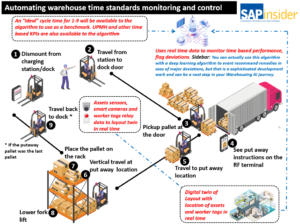Automating Monitoring and Control of Warehouse Time Standards
by Kumar Singh, Research Director, Automation & Analytics, Supply Chain Management, SAPinsider
Critical role of time standards in Warehouse operations
A warehouse manager can use time standards in a variety of applications and in virtually any type of working environment. Some of these applications are explained below:
- Estimating Labor requirements
- Scheduling jobs and workflows
- Providing measures of productivity
- Evaluating alternating options
- Improving warehouse operations
- Providing real time values for simulation analysis
- Benchmarking against Industry standards
Time Standard Techniques
There are generally four widely used techniques for developing time standards, but I have used the following two in my Algorithm setup:
Time Study: Most widely used. Times are determined from actual stopwatch timing of an operation. A stopwatch time standard is established by breaking down the operations into small elements that can be readily timed.
Pre-determined time standards: It is a collection of ready made time values for basic motion elements. This includes predetermined motion time systems (PMTS), which were originally developed by experienced analysts who agreed on certain basic factors, concepts and constraints underlying their systems. Some examples are:
- Methods time measurement (MTM)
- Work factor system (WFS)
- Dimensional motion times (DMT)
Developing initial time standards is a manual process, if done via Time study. For our architecture, we will assume that we already have determined what the
Our example process – Putaway
Explaining the architecture for end to end Warehouse operations is much much beyond the scope of this article so we will use just one process as an example. The process that we will be using for our example is the putaway process. Here are the key elements of a pallet putaway process:
- Mount/dismount reach truck
- Travel from battery charging to palletizing station (empty)
- Obtain pallet at palletizing station
- Read putaway directions on RF terminal
- Travel to location from palletizing station (loaded)
- Vertical travel at putaway location (loaded)
- Insert pallet in rack
- Lower folrks at putaway location (empty)
- Travel to palletizing station (empty)
- Travel to battery charging from putaway (after all putaways)
High Level logic of the algorithm

Implementation and execution are the key
As with any solution, there are no cookie cutter solutions. This architecture is suggestive and needs to be customized around your unique operations. Careful implementation is critical, which means looking beyond any pilots- and even understanding if this is something that will be beneficial at all in your warehouse operations environment.
What does this mean for SAPinsiders ?
While the solution above leverages sensors, tags and smart cameras, you can actually automate capturing process cycle time using RFID data that your SAP environment currently supports. It will not be as granular as the one discussed here but the good aspect of using RFID data to develop such capability initially is that there are many visibility solutions in SAP ecosystem that capture this data. There is no shame in starting to experiment with the technology you already have- building innovative capabilities is more about mindset and culture. So embarking on something like this with your RFID data as well will help you develop a culture in your warehouse operations that can embrace more advanced initiatives like the one discussed in this article.
Kumar Singh, Research Director, Automation & Analytics, Supply Chain Management, SAPinsider, can be reached at kumar.singh@wispubs.com








